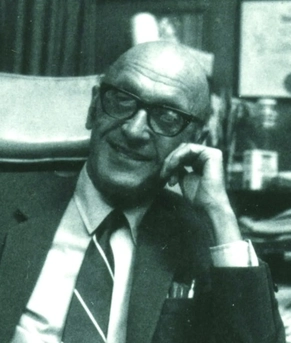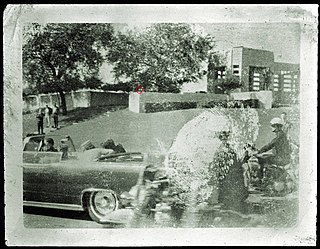Related Research Articles

On November 22, 1963, John F. Kennedy, the 35th president of the United States, was assassinated while riding in a presidential motorcade through Dealey Plaza in Dallas, Texas. Kennedy was in the vehicle with his wife, Jacqueline, Texas Governor John Connally, and Connally's wife, Nellie, when he was fatally shot from the nearby Texas School Book Depository by former U.S. Marine Lee Harvey Oswald. The motorcade rushed to Parkland Memorial Hospital, where Kennedy was pronounced dead about 30 minutes after the shooting; Connally was also wounded in the attack but recovered. Vice President Lyndon B. Johnson was hastily sworn in as president two hours and eight minutes later aboard Air Force One at Dallas Love Field.

Norma Jean Lollis Hill was an American woman who was an eyewitness to the assassination of United States President John F. Kennedy in Dallas, Texas, on November 22, 1963. Hill was known as the "Lady in Red" because of the long red raincoat she wore that day, as seen in Abraham Zapruder's film of the assassination. A teacher by profession, she was a consultant for Oliver Stone's 1991 film JFK and co-wrote JFK: The Last Dissenting Witness with Bill Sloan.

The single-bullet theory, also known as the magic-bullet theory by conspiracy theorists, was introduced by the Warren Commission in its investigation of the assassination of U.S. President John F. Kennedy to explain what happened to the bullet that struck Kennedy in the back and exited through his throat. Given the lack of damage to the presidential limousine consistent with it having been struck by a high-velocity bullet, and the fact that Texas Governor John Connally was wounded and was seated on a jumper seat 1+1⁄2 feet in front of and slightly to the left of the president, the Commission concluded they were likely struck by the same bullet.

Dealey Plaza is a city park in the West End Historic District of downtown Dallas, Texas. It is sometimes called the "birthplace of Dallas". It was also the location of the assassination of John F. Kennedy in 1963. Thirty minutes after the shooting, Kennedy was pronounced dead at Parkland Memorial Hospital. The Dealey Plaza Historic District was named a National Historic Landmark on the 30th anniversary of the assassination, to preserve Dealey Plaza, street rights-of-way, and buildings and structures by the plaza visible from the assassination site, that have been identified as witness locations or as possible locations for the assassin.

Abraham Zapruder was a Ukrainian-born American clothing manufacturer who witnessed the assassination of United States President John F. Kennedy in Dallas, Texas, on November 22, 1963. He unexpectedly captured the shooting in a home movie while filming the presidential limousine and motorcade as it traveled through Dealey Plaza. The Zapruder film is regarded as the most complete footage of the assassination.
The Babushka Lady is an unidentified woman present during the 1963 assassination of US President John F. Kennedy who might have photographed or filmed the events that occurred in Dallas’ Dealey Plaza at the time President John F. Kennedy was shot. Her nickname arose from the headscarf she wore, which was similar to scarves worn by elderly Russian women. бабушка – babushka – literally means "grandmother" or "old woman" in Russian.

Mary Ann Moorman is an American woman who chanced to photograph US President John F. Kennedy a fraction of a second after he was fatally shot in the head in Dallas, Texas. The Badge Man, whom conspiracy theorists claim is one of Kennedy's assassins, is purportedly visible in another of her photographs taken that day.
Charles F. Brehm was a very close witness to the assassination of United States President John F. Kennedy in Dallas, Texas on November 22, 1963.
Rosemary Willis was a close witness during the assassination of United States President John F. Kennedy.

A Dictabelt recording from a motorcycle police officer's radio microphone stuck in the open position became a key piece of evidence cited by the House Select Committee on Assassinations (HSCA) in their conclusion that there was a conspiracy behind the assassination of John F. Kennedy on November 22, 1963. Made on a common Dictaphone-brand dictation machine that recorded sound in grooves pressed into a thin vinyl-plastic belt, the recording gained prominence among Kennedy assassination conspiracy theorists following the HSCA's 1978 conclusion, based in part on this evidence, that there was a "high probability" that Lee Harvey Oswald did not act alone and that the Kennedy assassination was the result of a conspiracy.

The Badge Man is a figure that is purportedly present within the Mary Moorman photograph of the assassination of United States president John F. Kennedy in Dealey Plaza on November 22, 1963. Conspiracy theorists have suggested that this figure is a sniper firing a weapon at the president from the grassy knoll. Although a reputed muzzle flash obscures much of the detail, the Badge Man has been described as a person wearing a police uniform—the moniker itself derives from a bright spot on the chest, which is said to resemble a gleaming badge.
The John F. Kennedy assassination rifle is the long-barrelled firearm that was used to assassinate John F. Kennedy, the 35th President of the United States.

James William "Ike" Altgens was an American photojournalist, photo editor, and field reporter for the Associated Press (AP) based in Dallas, Texas, who became known for his photographic work during the assassination of United States President John F. Kennedy (JFK). Altgens was 19 when he began his AP career, which was interrupted by military service during World War II. When his service time ended, Altgens returned to Dallas and got married. He soon went back to work for the local AP bureau and eventually earned a position as a senior editor.
Linda Kay Willis was a close witness during the assassination of United States President John F. Kennedy.
Orville Orhel Nix was a witness to the assassination of United States President John F. Kennedy in Dallas, Texas on November 22, 1963. His filming of the shooting, which only captured the last few seconds of it, but shows the grassy knoll in its entirety, is considered to be nearly as important as the film by Abraham Zapruder.
Marie M. Muchmore was one of the witnesses to the assassination of United States President John F. Kennedy in Dallas, Texas, on November 22, 1963. A color 8 mm film that Muchmore made is one of the primary documents of the assassination. The Muchmore film, with other 8 mm films taken by Abraham Zapruder and Orville Nix, was used by the Warren Commission to investigate the assassination and to position the presidential limousine in a forensic recreation of the event in May 1964.
Marilyn Sitzman was an American receptionist and a witness to the assassination of United States President John F. Kennedy in Dallas, Texas, on November 22, 1963. She was steadying her boss, Abraham Zapruder, as he stood atop a pergola in Dealey Plaza making what has since become to be known as the Zapruder film, the most studied record of the assassination.

The Zapruder film is a silent 8mm color motion picture sequence shot by Abraham Zapruder with a Bell & Howell home-movie camera, as United States President John F. Kennedy's motorcade passed through Dealey Plaza in Dallas, Texas, on November 22, 1963. Unexpectedly, it captured the President's assassination.

The assassination of President John F. Kennedy on November 22, 1963, has spawned numerous conspiracy theories. These theories allege the involvement of the CIA, the Mafia, Vice President Lyndon B. Johnson, Cuban Prime Minister Fidel Castro, the KGB, or some combination of these individuals and entities. Some conspiracy theories have alleged a coverup by parts of the federal government, such as the original FBI investigators, the Warren Commission, or the CIA. Former Los Angeles District Attorney Vincent Bugliosi estimated that a total of 42 groups, 82 assassins, and 214 people had been accused at one time or another in various conspiracy scenarios.

Pictures of the Pain: Photography and the Assassination of President Kennedy is a 1994 book by Richard B. Trask, an American historian and archivist based in Danvers, Massachusetts. The book compiles more than 350 photographs made by amateur and professional photographers in Dallas, Texas, during the November 1963 assassination of United States President John F. Kennedy, and includes interviews with many of the people who made the images, some of which had never been published prior to the book's release.
References
- 1 2 3 4 5 "Testimony of Phillip L. Willis". Hearings Before the President's Commission on the Assassination of President Kennedy. Vol. VII. Washington, D.C.: United States Government Printing Office. 1964. pp. 492–497.
- 1 2 3 4 5 6 7 8 9 10 11 12 Simnacher, Joe (January 28, 1995). "Pearl Harbor survivor Phillip Willis dies at 76" (PDF). The Dallas Morning News. Dallas, Texas. pp. 33A, 37A. Retrieved July 23, 2012.
- 1 2 3 "74(R) HCR 179 Introduced version - Bill Text". www.legis.state.tx.us.
- 1 2 3 Moore, Jim (1990). "Chapter VII: Pictures Don't Lie". Conspiracy of One: The Definitive Book on the Kennedy Assassination . Fort Worth, Texas: The Summit Group. p. 123. ISBN 9780962621925.
- ↑ Bryant, Megan. "Argus Autronic I Model 35156-M 35mm camera". The Sixth Floor Museum at Dealey Plaza.
- ↑ Before, during, and after the assassination. Trask, p. 108. Willis published a set of twelve slides in November 1964. U.S. Copyright Office, copyright registration #PA0000000068, registered January 31, 1978.
- ↑ "Willis Ex 1 - Series of 12 photographs relating to the assassination with 2 pages of descriptive material." (PDF). Hearings Before the President's Commission on the Assassination of President Kennedy (pdf). Vol. XXI. Washington, D.C.: United States Government Printing Office. 1964. pp. 765–773. Retrieved July 31, 2012.
- ↑ Zapruder film frame 202.
- 1 2 HSCA Appendix to Hearings, vol. 6, p. 44, The Number, Timing, and Source of the Shots Fired at the Presidential Limousine: The Trajectory Analysis. HSCA Appendix to Hearings, vol. 6, p. 121, Conspiracy Questions: Alleged Gunmen in Dealey Plaza. The Warren Commission, inaccurately, estimated that Willis's fifth photo was taken at Z-210. Warren Commission Report, p. 112, The Shot That Missed: The First Shot.
- ↑ HSCA Appendix to Hearings, vol. 12, p. 7, Presence of Possible Gunman on the Grassy Knoll.
- ↑ "Witness Recall Seeing 2 Figures". Reading Eagle. Reading, California. UPI. June 5, 1979. p. 2. Retrieved March 8, 2013.